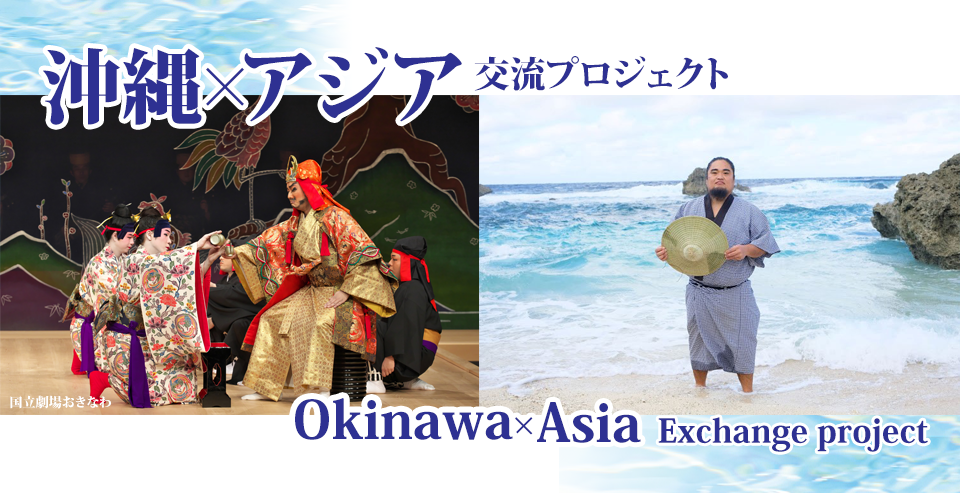
Archived video of the round table discussion is available at the link below.
Bringing Asia together through Intangible Cultural Heritage –Round table discussion (YouTube)
The Japan Foundation Asia Center's Okinawa×Asia Exchange Project aims to connect Okinawa with countries throughout Asia. "Bringing Asia together through Intangible Cultural Heritage" is a new project being launched in February 2022 in collaboration with the National Theatre Okinawa.
The islands of Okinawa have been connected politically, economically, and culturally to Asia since ancient times. Also, each country and region in Asia has a great variety of traditional performing arts that have been passed down to the present day.
This event is based at the National Theatre Okinawa, a hub for the exchange of traditional culture in the Asia-Pacific region and consisting of two main programs; the video series for introducing traditional performing arts of six Asian countries, and a round table talk welcoming participants who have deep connections to the traditional performing arts of each country.
The video series will cover six performing arts: Indian Kutiyattam (Sanskrit classic play), Wayang golek (puppet theater) from Indonesia, Mak yong dance from Malaysia, Khon masked theatre from Thailand, Nha nhac Vietnamese court music, and Kumiodori musical theater from Okinawa, all of which are listed on the list of UNESCO's World Intangible Cultural Heritage. On February 9, an online round table talk connecting six countries will be held featuring guest speakers associated with the aforementioned traditional performing arts.
We will learn about the characteristics and the histories of each performing art and gain an understanding on how they are being preserved for future generations. The goal is to help invigorate the performing arts of Asia and build a broader network for participants to take advantage of.
Video release of traditional performing arts of Asia
Videos are available on the National Theatre Okinawa's official YouTube channel.
Details of Performing arts from participating countries
Round table talk – Bringing Asia together through Intangible Cultural Heritage
The archived video is available on YouTube.
| Date and Time | Wednesday, February 9, 2022 at 6:30 p.m. (Venue opens at 6:00 p.m.) |
|---|---|
| Venue |
National Theatre Okinawa |
| Speakers |
|
| Moderator | FUKUOKA Shota (Professor, National Museum of Ethnology) |
| Languages | Japanese, English (interpretation available) |
| Admission | Free, Capacity: 20 seats (Reservation required) Reserve by phone: 098-871-3308 (National Theatre Okinawa. Office hours: Weekdays 10:00 a.m.-6:00 p.m.) Reserve online: Please apply from the National Theatre Okinawa official website (Only in Japanese, available 24 hours) * Reservations accepted until Wednesday, February 9 12:00 p.m. * The event will also be live broadcast on the National Theatre Okinawa official YouTube channel. (Free of charge, no reservation required, available only in Japanese) |
| Hosted by | The National Theatre Okinawa Management Foundation, The Japan Foundation Asia Center |
| Contact | Arts, Culture and Exchange Section 2 The Japan Foundation Asia Center Tel: 03-5369-6045 E-mail: ab2@jpf.go.jp |
Participating speakers and groups
Gopal Venu (India)
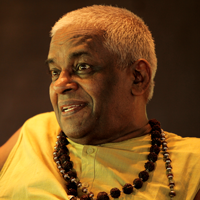
A performer, teacher and scholar of Kutiyattam. He is also the founder and chairman of Natanakairali. Kutiyattam is a form of classical Sanskrit play that was added to the UNESCO Intangible Cultural Heritage list in 2008 and studied under Ammannur Madhava Chakyar, who was a doyen of Kutiyattam. His major contributions are his adaptations of the plays by Kālidāsa and Bhāsa for Kutiyattam. He is also a visiting Teacher of Kutiyattam at the National School of Drama in Delhi as well as Intercultural Theatre Institute in Singapore. Venu has been awarded for his contribution to the rejuvenation of multiple rare traditional art forms of Kerala, which include the Kerala Sahitya Akademi Award (1977), and the Nikkei Asia Prize for Culture (2007).
Kapila Venu (India)
Kutiyattam performer born in Kerala, India. Student of Ammannur Madhava Chakyar and her father Gopal Venu. She aims to introduce new roles and stories from a new perspective, all while remaining faithful to the traditional classics. She conducts research into and aims to revive traditional performing arts from Kerala such as the classical dance called Mohiniyattam, and currently serves as Executive Director of Natanakairali.
Natanakairali, The Research Training and Performing Centre for Traditional Arts (India)
Founded by Gopal Venu in 1975 with the goal of preserving and popularizing the then-declining traditional performing arts of Kerala. Its mission consists of five primary objectives: (1) Educate the next generation of performers, (2) Revitalize the traditional performing arts, (3) Create opportunities for artists to earn a livelihood while performing, (4) Build a platform for collaboration between artists, and (5) Revive abandoned arts and expand artistic styles. The Centre has made significant contributions to the growth and development of various classical, ethnic, and ceremonial performing arts styles from Kerala including Kutiyattam, Nangyar koothu, Mohiniyattam, Mudiyettu, Kathakali, and more. Its rigorous training system has brought Natanakairali international renown as a center for the performing arts with exacting standards.
Endo Suanda (Indonesia)

Ethnomusicologist and director of Lembaga Pendidikan Seni Nusantara (LPSN) and the head of Tikar Media. He has performed in, directed, and produced numerous Wayang golek (puppet plays from Western Java) and Topeng Cirebon (Cirebonese masked dance) plays since the 1970s, and has given many performances and held many workshops and lectures in both Indonesia and overseas. Has played a key role in education and research through his activities at educational institutions around the world, and his participation in academic projects such as "Multiculturalism" (multifaceted research projects in Indonesia that delve into multiculturalism in the performing arts through workshops, seminars, and archiving of audio and video materials).
Lembaga Pendidikan Seni Nusantara (LPSN) (Indonesia)
A not-for-profit NGO founded by artists, researchers and art-educators in 2002. Its main purpose is to develop curricula and teaching materials of art and culture for junior and senior high schools in Indonesia. LPSN had completed 10 topics of teaching materials including string instruments, textiles, popular music and theater in the form of books and audiovisual packages. The materials have been distributed to art teachers from 1,000 schools in Indonesia, and implemented in schools that reached about 100,000 students. LPSN has also developed a system of documentation and audiovisual archives of arts and culture. Since 2015, LPSN focuses on workshops and laboratories for acoustic bamboo musical instruments.
Eddin Khoo (Malaysia)
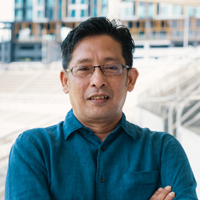
Poet, author, translator, journalist, and founder of PUSAKA. PUSAKA is a non-profit organization that collaborates with local traditional performing arts and ceremonial groups practicing throughout Malaysia and serves as one of the key regional cultural centers. He is Executive Editor of the news site The Vibes, and oversees the Culture & Lifestyle, News Features, and Southeast Asia sections. He researches and works on oral transmission, ceremony, culture, religion, and political aspects of the traditional performing arts alongside prominent artists in other fields, and actively contributes commentary and articles on major news and art platforms around the world.
PUSAKA (Malaysia)
A cultural organization dedicated to revitalizing and strengthening the viability of cultural traditions at the community level. PUSAKA organizes regular public performances and community instruction projects, supporting the transmission of the cultural traditions. Along with working intimately with outstanding performers and masters of traditional and oral performing arts from all over Malaysia, PUSAKA also engages audiences by bringing internationally renowned virtuosos to its performances. PUSAKA also conducts extensive audio-visual and written documentation of the various traditions, to create a comprehensive documentary archive of cultural, ritual and performance traditions in Malaysia.
Suksanti Wangwan (Thailand)
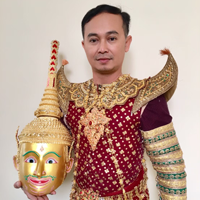
Assistant professor at the Bunditpatanasilpa Institute (Ministry of Culture) and performer of classical Thai dance. Specializes in Khon masked drama. He studied Thai dance at the Roi Et College of Dramatic Arts (Thai Dramatic Arts Conservatory), and holds a master's and doctorate in Thai Theatre and Dance, Faculty of Fine and Applied Arts at Chulalongkorn University. He has been working as a Thai classical dance master, transmitting Thai classical dance at Angthong College of Dramatic Arts for more than 30 years, and has been expanding Thai classical dance knowledge and practices on various occasions including Thai and international conferences, festivals and performances.
Bunditpatanasilpa Institute (Ministry of Culture) (Thailand)
Founded in 1998 as a national institution of art with the objective of handing down and popularizing the traditional Thai court performing arts. The institution teaches the basics of local and international theater, music, and videography, and offers education at the advanced, professional level as well, and has produced a number of highly skilled graduates over the years. In addition, the institute works to train researchers in the accumulation of knowledge of performing arts, and in their study and preservation. The level of education offered has been recognized worldwide as highly professional. As leaders in the field of the arts, it continues to promote Thai art around the world, contributing to the development of Thai art and culture.
Hoang Trong Cuong (Vietnam)

Vice Chairman of Thua Thien Hue Theatre Artists Association and Vice Director of The Theatre Of Hue Traditional And Royal Arts, directly under Hue Monuments Conservation Centre. He performs proficiently various types of court music with traditional musical instruments and joined overseas concerts such as in Japan, South Korea, Thailand and several countries in Europe. He is an active music teacher, passing on the knowledge of court music to the younger generation in order to preserve it as intangible cultural heritage for the future. In 2019, he was conferred Meritorious Artist in Vietnam.
The Theatre Of Hue Traditional And Royal Arts (Vietnam)
Established in 1994 as an institute for preserving and developing forms of royal art including Nha nhac. Up to now, the theatre has collected, arranged and performed over forty pieces of rite music and special royal dances/typical extracts of royal classical dramas and many special repertoires of the theatre have been performed in art festivals at home and abroad. The theatre has been awarded an assortment of noteworthy prizes. The devotion of the artists has been admitted with noble titles granted by the government. At present, the theatre has one People’s Artist and nine Meritorious Artists.
KAKAZU Michihiko (Japan)
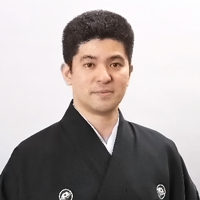
Studied under MIYAGI Nozo I and MIYAGI Nori and teaches at the Miyagi Ryu Nori No Kai. Folklore keeper at the Traditional Kumiodori Preservation Society and the Ryukyuan Dance Preservation Society. He completed his master's degree at the Graduate School of Music Arts at the Okinawa Prefectural University of Arts. After working as a part-time lecturer at Okinawa Prefectural University of Arts, he was appointed Artistic Director of the National Theatre Okinawa where he has served since 2013. He received the Okinawa Times Art Award Grand Prize and the Matsuo Performing Arts Award for Newcomers to Dance.
KINJO Shinji (Japan)
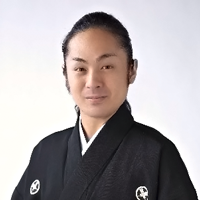
Studied under TANITA Yoshiko and KINJO Mieko. Teacher at Tamagusuku Ryu Senju Kai and Folklore Keeper at the Traditional Kumiodori Preservation Society and the Ryukyuan Dance Preservation Society. He holds a title in "Ryukyu Opera", recognized by Okinawa Prefecture as an Intangible Cultural Property. Completed his master's degree at the Graduate School of Music Arts at the Okinawa Prefectural University of Arts. Completed the Kumiodori course at the National Theatre Okinawa (in the first class of students). Since December 2021, has served as Artistic Advisor to the National Theatre Okinawa Management Foundation and will take over as Artistic Director in April 2022. He received the highest award at the Ryukyu Shimpo Ryukyu Classical Art Contest and the Okinawa Times Art Encouragement Award.
National Theatre Okinawa (Japan)
The National Theatre Okinawa opened its doors in Urasoe City, Okinawa, in January 2004. The Theatre preserves and promotes traditional Okinawan arts such as Kumiodori, a nationally-recognized Important Intangible Cultural Property, and to harness the geographic and historical position held by Okinawa to become a hub for the exchange of traditional culture in the Asia-Pacific region. The theatre has four primary operating goals: provide public performances of Kumiodori and other forms of Ryukyuan dance and music; train newcomers in Kumiodori dance and other local traditions; conduct research, collect data, and make records of public performances for future exhibit; and engage in cultural exchange with other regions of the Asia-Pacific through traditional performing arts.
FUKUOKA Shota (Moderator)
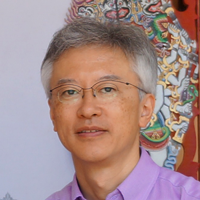
Professor of Ethnomusicology at the National Museum of Ethnology. He specializes in the music of Southeast Asia, particularly the Sundanese music of West Java, Indonesia. Co-author of such works as Popular Culture in Southeast Asia: Identity, Nation, and Globalization (Stylenote, 2018) and Twelve Perspectives on Folk Music (ONGAKU NO TOMO SHA, 2016). He has led various research projects, including, Traditional performing arts issues in island societies (2018), Constructing a forum-type information museum to the traditional performing arts of Tokunoshima (2014-2016), and Cultural development and exchange through mass media in East Asia in the 1930s (2005-2010).
Performing arts from participating countries
India: Kutiyattam
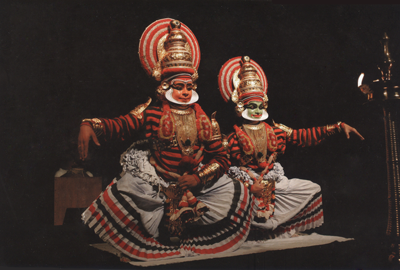
The world's oldest surviving example of Sanskrit classic play. It has been handed down for over a thousand years within designated families working for Hindu temples in the southwestern Indian state of Kerala. In Kutiyattam, complex hand gestures called mudra are used to express each and every word, and the eyes and facial expressions are used to communicate detailed emotions. It was added on the Representative List of UNESCO Intangible Cultural Heritage in 2008.
Indonesia: Wayang golek
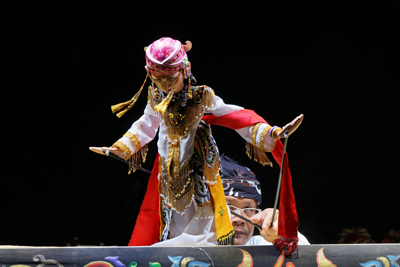
Traditional puppet theater from the Sundanese people of West Java, Indonesia. Accompanied by gamelan music, a single puppeteer controls multiple wooden puppets, narrating and singing along in time to the gamelan ensemble. Often seen at ceremonies for circumcisions, weddings, rice planting, and harvests. It was added on the Representative List of UNESCO Intangible Cultural Heritage in 2003.
Malaysia: Mak yong
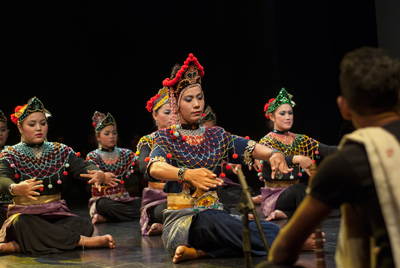
Traditional Malaysian theatrical song and dance. It arose in the Malay-dominated court of what is now Southern Thailand, before being brought to Kelantan on the east coast of the Malay Peninsula more than 200 years ago. In the past, it was a popular among common folk in the rural villages of Malaysia's northeast coastal area and southern Thailand and was performed for both entertainment and as a form of medical treatment. The performers are mainly women, who gracefully move their fingers, hands, and arms as they sing and dance. It was added on the Representative List of UNESCO Intangible Cultural Heritage in 2005.
Thailand: Khon
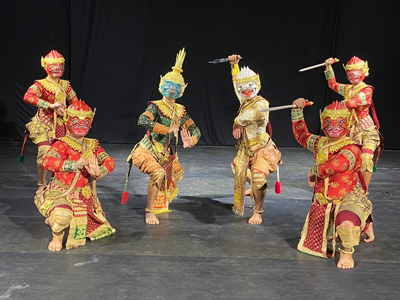
Khon (Thai Masked Dance-Drama) is one of the classical Thai dance-drama passed down over 400 years; the Khon actors are wearing a mask called "hua khon" (literally means the khon head). The narrative of the Khon performance is from the Ramakian epic influenced by the Indian Ramayana, and the prominent dance figure of the Khon was developed from the acrobatic figure and martial arts.
It was added on the Representative List of UNESCO Intangible Cultural Heritage in 2018.
Vietnam: Nha nhac
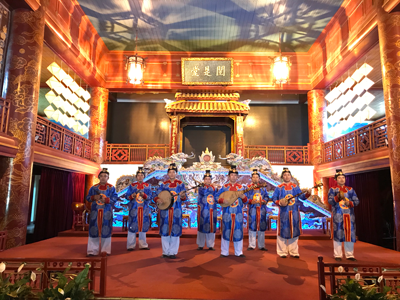
Traditional court music from Vietnam's ancient capital of Hue. It developed in the 15th century Le Dynasty, and established itself as a form of court music in the 19th century Nguyen Dynasty. Nha nhac is performed by many musicians, singers, and dancers wearing stunning costumes. In the 20th century, the art was almost lost with the fall of the Nguyen Dynasty and the wars that lasted for several decades, however as a result of its maintenance by the few remaining court musicians, its value was reevaluated worldwide, and in 2008 it was added on the Representative List of UNESCO Intangible Cultural Heritage.
Okinawa: Kumiodori
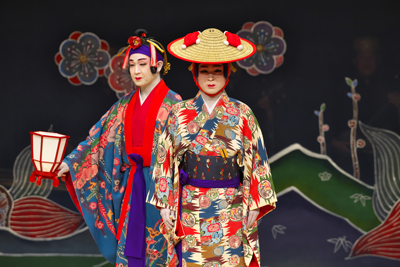
Traditional Okinawan theater that harnesses chanting, music, and dance, and is characterized by its use of ancient Okinawan language, and Ryukyuan music and dance. It was created in the early 18th century to entertain an envoy from the emperor of China, by dancer and bureaucrat TAMAGUSUKU Chokun, who based it on traditional Ryukyuan performing arts and history, incorporating elements from Noh, Kabuki, and Chinese theater. Designated a national Important Intangible Cultural Property in 1972, and added on the Representative List of UNESCO Intangible Cultural Heritage in 2010.









